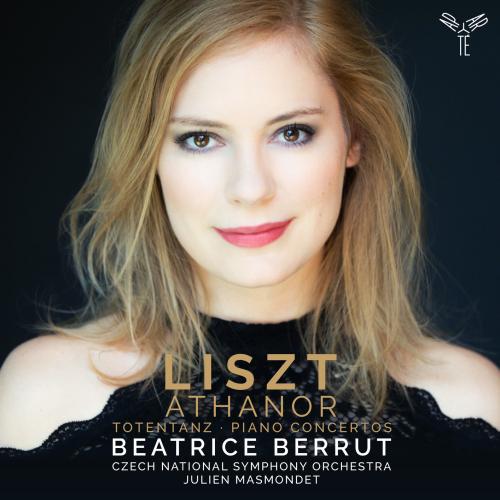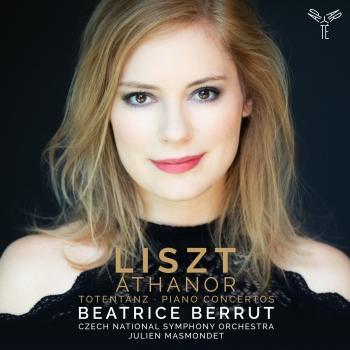
Liszt: "Athanor", Totentanz & Piano Concertos Beatrice Berrut, Czech National Symphony Orchestra & Julien Masmondet
Album Info
Album Veröffentlichung:
2018
HRA-Veröffentlichung:
27.04.2018
Label: Aparté
Genre: Classical
Subgenre: Concertos
Interpret: Beatrice Berrut, Czech National Symphony Orchestra & Julien Masmondet
Komponist: Franz Liszt (1811-1886)
Das Album enthält Albumcover Booklet (PDF)
- Franz Liszt (1811 - 1886): Totentanz:
- 1 Totentanz. Paraphrase on "Dies Irae" for Piano and Orchestra, S. 126 15:52
- Piano Concerto No. 1 in E-Flat Major, S. 124:
- 2 Piano Concerto No. 1 in E-Flat Major, S. 124: I. Allegro maestoso 05:34
- 3 Piano Concerto No. 1 in E-Flat Major, S. 124: II. Quasi adagio 04:46
- 4 Piano Concerto No. 1 in E-Flat Major, S. 124: III. Allegretto vivace - Allegro animato 04:13
- 5 Piano Concerto No. 1 in E-Flat Major, S. 124: IV. Allegro marziale animato 04:08
- Piano Concerto No. 2 in A Major, S. 125:
- 6 Piano Concerto No. 2 in A Major, S. 125: I. Adagio sostenuto assai - Allegro agitato assai - Un poco più mosso - Tempo del andante 07:11
- 7 Piano Concerto No. 2 in A Major, S. 125: II. Allegro moderato 05:18
- 8 Piano Concerto No. 2 in A Major, S. 125: III. Allegro deciso - Marziale un poco meno allegro - Un poco meno mosso 07:05
- 9 Piano Concerto No. 2 in A Major, S. 125: IV. Allegro animato 01:46
Info zu Liszt: "Athanor", Totentanz & Piano Concertos
Athanor. A mysterious name to designate, in alchemy, the long-combustion furnace that produces the philosopher’s stone. This matrix, which symbolises the quest of one who seeks to the Absolute, is a metaphor of Liszt’s approach.
With the patience of the alchemist who pursues the perfection of the material, the virtuoso composer and pianist has long matured the genesis of his two Piano Concertos and of the Totentanz: in fact, more than 20 years separate the first sketches of their publication.
These three major works are each crossed by a powerfull and captivating leading theme, and driven by a logic of transformation: the Totentanz uses the theme and variations form while the concertos are unifyed by a unique theme that nourishes the whole musical flow through its metamorphoses.
Pianist Beatrice Berrut, who was already venturing on the Lisztian paths in her previous record, testifies here to the infinite invention of the composer: she performs the first Concerto with its last variants noted by Liszt himself on the copy of his pupil Hans von Bülow.
Beatrice Berrut, piano
Czech National Symphony Orchestra
Julien Masmondet, conductor
Beatrice Berrut
geboren im Wallis am Fuße der Schweizer Alpen, verbringt ihre Kindheit mit ihrer Schwester auf tief verschneiten Hängen – mit zwei fährt sie schon Ski – und so manche felsige Majestät erklimmend. Diese Nähe und die tiefe Verbundenheit zu den steinernen Riesen ihrer Heimat und der Natur begleiten sie noch heute auf ihren musikalischen Reisen.
Früh schon prägt der wundersame Klang des Klaviers ihre Vorstellungskraft, gibt es – dank ihrer Mutter – doch keinen Abend wo beide Schwestern nicht zu den Melodien von Schumanns Kinderszenen oder Mendelssohns Liedern ohne Worte einschlafen. Von der Klangwelt der großen schwarzen Holzkiste, die schöne und ausdrucksvolle Harmonien erklingen lässt, fasziniert, nimmt Beatrice Berrut mit 8 Jahren ihren ersten Klavierunterricht. Sie übt mit großer Neugier und Beständigkeit, denn eine neue Welt, abseits von Schule und Alltag, will erkundet werden. Wenige Jahre später wird sie vom Klavierklang völlig vereinnahmt: Beatrice hört das erste Mal das zweite Klavierkonzert von Johann Brahms. Es ist ein existentieller, harmonischer Schock, der die Elfjährige dazu bewegt den Kosmos der Musik komplett ihr eigen nennen zu wollen. Beatrice entschließt sich dazu Pianistin zu werden.
Nach unzähligen müßigen Tastenausflügen und zahlreichen Spaziergängen am Ufer des Genfer Sees entdeckt Beatrice die großen Komponisten und ihre in schwarz-weißen Notensystemen festgehaltenen Gedanken. Liszt – der selbst in der Schweiz Inspiration suchte und sie auch fand – wird zu einem zentralen Charakter in ihrem Leben. Das Vallée d’Obermann ist das Tal, in dem sie selbst aufgewachsen ist, und manchmal scheint es, dass sie während ihrer Wanderungen in den Bergen die tiefe Bedeutung seiner Werke am Horizont schimmern sehen kann. ...
Booklet für Liszt: "Athanor", Totentanz & Piano Concertos












